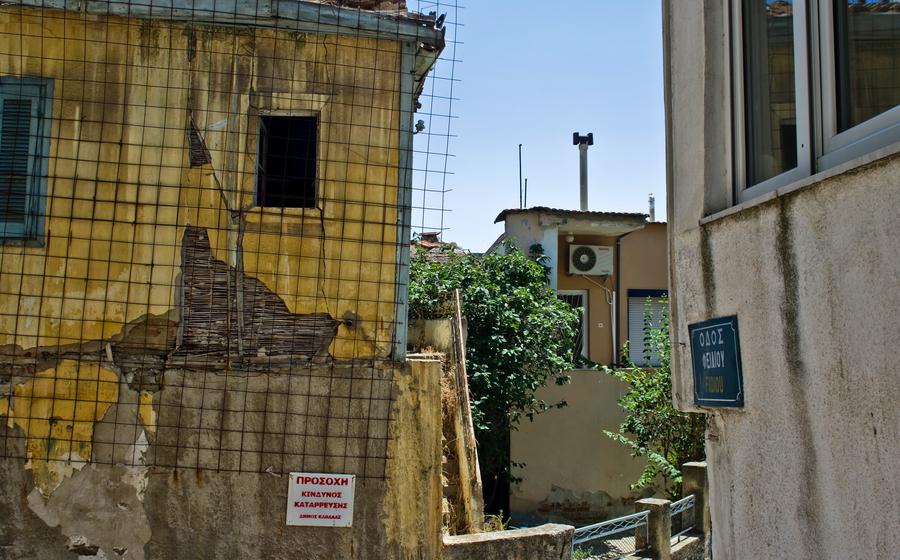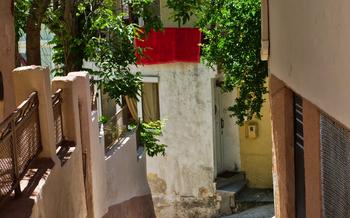
The Zarkadia Arched Stone Bridge
- History of the Zarkadia Arched Stone Bridge
- Architectural Features
- Location and Accessibility
- Scenic Beauty
- Nearby Attractions
- Things to Do
- Legends and Folklore
- Restoration and Preservation
- Architectural Significance:
- Local Cuisine
- Accommodations
- Photography Tips
- Visitor Etiquette
- Insider Tip: Discovering the Hidden Gem of Agios Nikolaos Church
History of the Zarkadia Arched Stone Bridge
The Zarkadia Arched Stone Bridge, also known as the Stone Bridge of Zarkadia, is a remarkable architectural marvel nestled in the picturesque village of Zarkadia, Greece. Its origins can be traced back to the 18th century, during the Ottoman period. Constructed by skilled local craftsmen using traditional techniques, the bridge served as a vital connection between the village and the surrounding areas, facilitating trade, travel, and communication. The bridge's strategic location over the Zarkadia River allowed for the efficient movement of goods and people, contributing to the economic and social development of the region.
Throughout history, the Zarkadia Arched Stone Bridge has borne witness to numerous significant events and played a pivotal role in shaping the local culture and heritage. Its enduring presence has made it an iconic landmark, deeply embedded in the collective memory of the community. The bridge has become a symbol of resilience, standing steadfast against the test of time and the elements, serving as a reminder of the region's rich history and architectural prowess.
Architectural Features
The Zarkadia Arched Stone Bridge is a remarkable feat of engineering and architecture, showcasing unique design elements and construction techniques. Built entirely of stone, the bridge features a graceful arch that spans the Nestos River, creating a visually striking and harmonious structure. The stones used in its construction were carefully selected and meticulously fitted together without the use of mortar, demonstrating the exceptional craftsmanship of the builders.
The bridge's design incorporates innovative engineering solutions, such as the use of buttresses and piers to distribute the weight of the structure evenly and ensure its stability. These architectural elements not only enhance the bridge's structural integrity but also add to its visual appeal, creating a sense of strength and elegance.
Despite its age, the Zarkadia Arched Stone Bridge has stood the test of time, withstanding the forces of nature and the passage of centuries. Its resilience is a testament to the skill and ingenuity of its builders, who created a structure that has endured for generations.
Location and Accessibility
The Zarkadia Arched Stone Bridge is situated in the picturesque village of Zarkadia, nestled amidst the lush greenery of the Pangeo mountains in the Kavala region of Greece. Reaching the bridge is a journey in itself, offering breathtaking views of the surrounding landscape. Visitors can embark on a scenic drive along winding roads, passing through quaint villages and olive groves.
Multiple transportation options are available for those without a vehicle. Regular bus services connect Kavala city to Zarkadia, making it convenient for travelers to reach the bridge. Alternatively, taxis and rental cars provide greater flexibility for exploring the region at your own pace.
Once in Zarkadia, follow the signs leading to the bridge. A short walk through the village's charming streets will bring you to this architectural marvel, where you can marvel at its grandeur and immerse yourself in its history. The bridge's proximity to other attractions, such as the Zarkadia Folklore Museum and the Church of Agios Nikolaos, makes it an ideal starting point for exploring the village's cultural heritage.
For those with limited mobility, the bridge is easily accessible via a gently sloping path. The surrounding area is well-maintained, ensuring a safe and enjoyable experience for all visitors.
Scenic Beauty
The Zarkadia Arched Stone Bridge is nestled amidst a picturesque landscape that will take your breath away. The lush green valley, meandering river, and rolling hills create a serene and tranquil ambiance. As you approach the bridge, you'll be greeted by panoramic views that stretch as far as the eye can see. The bridge itself is a work of art, with its elegant arches and intricate stonework blending seamlessly with the natural surroundings.
The best time to visit the bridge for optimal photo opportunities is around sunrise or sunset when the warm golden light casts a magical glow on the landscape. The bridge's reflection in the calm waters of the river adds an enchanting touch, creating a scene that is both mesmerizing and unforgettable.
To capture the most stunning shots, position yourself at different vantage points around the bridge. Experiment with different angles and perspectives to create unique and captivating images. Don't forget to zoom in on the intricate details of the bridge's architecture, such as the weathered stonework and the graceful curves of the arches.
Nearby Attractions
In the vicinity of the Zarkadia Arched Stone Bridge, there is a wealth of other captivating attractions waiting to be explored. The picturesque village of Zarkadia, nestled amidst lush greenery, offers a glimpse into traditional Greek life, with its charming stone houses, narrow cobblestone streets, and welcoming locals. The village is renowned for its traditional handicrafts, including intricate textiles, pottery, and wood carvings, which can be found in the local shops and studios.
Just a short drive away, the Nestos River, with its crystal-clear waters and stunning gorges, beckons nature enthusiasts to embark on a thrilling adventure. Kayaking and rafting are popular activities, allowing visitors to navigate the river's currents and marvel at the breathtaking scenery. The Nestos River is also a haven for birdwatchers, with a diverse array of species, including eagles, hawks, and herons, soaring overhead.
History buffs will delight in exploring the ruins of the ancient city of Philippi, located a short distance from the bridge. Philippi, founded by Philip II, the father of Alexander the Great, was a prominent city in ancient Macedonia and played a pivotal role in Roman history. The ruins include an impressive amphitheater, a marketplace, and remnants of temples and fortifications, offering a glimpse into the city's glorious past.
For those seeking a spiritual experience, the Monastery of Panagia Eikosifoinissa, perched on a hilltop overlooking the Nestos River, is a must-visit. The monastery, dating back to the 11th century, is dedicated to the Virgin Mary and is renowned for its exquisite Byzantine frescoes and icons. Visitors can immerse themselves in the tranquil atmosphere, admire the intricate artwork, and learn about the monastery's rich history.
By combining a visit to the Zarkadia Arched Stone Bridge with these nearby attractions, travelers can create a comprehensive itinerary that showcases the diverse cultural, natural, and historical treasures of this captivating region.
Things to Do
The Zarkadia Arched Stone Bridge offers a range of activities and experiences for visitors to enjoy. For nature enthusiasts, the surrounding area is a haven for hiking and nature walks. There are well-maintained trails that meander along the river and through the picturesque landscapes, providing opportunities to explore the region's natural beauty.
For those seeking relaxation, the bridge is an ideal spot for picnicking and taking in the tranquil ambiance. There are designated picnic areas near the bridge, where visitors can spread out a blanket and enjoy a leisurely meal while surrounded by stunning scenery.
The bridge is also a popular destination for photography, sketching, and artistic pursuits. The picturesque views and unique architectural features of the bridge provide ample inspiration for capturing creative shots and creating beautiful works of art.
Throughout the year, the bridge hosts various seasonal events and activities. These events include traditional Greek festivals, concerts, art exhibitions, and cultural performances. These events offer visitors a chance to immerse themselves in the local culture and experience the vibrant spirit of the region.
Legends and Folklore
The Zarkadia Arched Stone Bridge has inspired countless myths, legends, and folktales over the centuries. Locals believe that the bridge is haunted by the spirits of those who lost their lives during its construction, and that their cries can be heard at night. Another legend tells of a young woman who threw herself off the bridge after her lover was killed in a battle. Her spirit is said to linger near the bridge, searching for her lost love.
The bridge is also associated with the story of Hercules, who is said to have crossed the river on his way to complete one of his twelve labors. According to the legend, Hercules was so impressed by the bridge's strength and beauty that he declared it a monument to human ingenuity and perseverance. These legends and stories have been passed down through generations, adding to the mystique and charm of the Zarkadia Arched Stone Bridge.
Restoration and Preservation
The Zarkadia Arched Stone Bridge has stood the test of time for over 500 years, but the relentless passage of time and the elements have taken their toll on its structure. In recent years, dedicated efforts have been made to preserve and maintain the bridge's structural integrity and historical value. Local authorities, in collaboration with heritage experts, have undertaken a comprehensive restoration project to address the bridge's vulnerabilities and ensure its longevity.
The restoration process involved meticulous inspection, assessment, and repair work. Craftsmen skilled in traditional masonry techniques carefully restored damaged sections of the bridge using materials that matched the original construction. The bridge's arches, pillars, and foundations were reinforced to withstand future environmental stressors and seismic activity.
Challenges in conserving the bridge were not limited to its physical condition. Balancing the need for preservation with the bridge's cultural significance was a delicate task. The restoration team aimed to maintain the bridge's authenticity while implementing necessary structural improvements. They consulted historical documents, consulted with experts in heritage conservation, and incorporated traditional techniques to ensure that the bridge retained its original character.
The successful restoration of the Zarkadia Arched Stone Bridge stands as a testament to the community's commitment to preserving its heritage. The bridge now stands as a symbol of resilience, blending its historical charm with modern engineering advancements. Visitors can safely traverse the bridge and immerse themselves in its rich history, knowing that it will continue to serve as a vital link between past and present for generations to come.
Architectural Significance:
The Zarkadia Arched Stone Bridge stands as a testament to the engineering prowess and architectural ingenuity of its time. Its unique design features and construction methods set it apart as a remarkable example of bridge architecture. The bridge's distinctive arched structure, consisting of multiple semi-circular arches, not only adds to its visual appeal but also contributes to its structural stability.
The materials used in the construction of the bridge further highlight its architectural significance. Locally sourced stones, carefully selected for their strength and durability, form the foundation of the bridge. These stones were meticulously cut and arranged to create a cohesive and robust structure.
The bridge's design incorporates several engineering innovations that contribute to its longevity and resilience. The use of buttresses and piers reinforces the bridge structure, ensuring its stability against the forces of the river and the passage of time.
Despite its age, the Zarkadia Arched Stone Bridge has withstood the test of time, remaining a testament to the architectural brilliance of its creators. Its ability to endure centuries of use and environmental challenges speaks to the exceptional craftsmanship and attention to detail that went into its construction.
The bridge's architectural significance extends beyond its local context. It is recognized as a valuable example of Ottoman-era bridge architecture, showcasing the cultural exchange and architectural influences that shaped the region during that period.
Comparisons with other similar bridges around the world reveal the uniqueness of the Zarkadia Arched Stone Bridge. While sharing certain design elements with other Ottoman-era bridges, it stands out with its distinct features and construction techniques.
Overall, the Zarkadia Arched Stone Bridge is an architectural masterpiece that embodies the fusion of engineering prowess and aesthetic beauty. Its significance lies in its unique design, innovative construction methods, and its enduring legacy as a symbol of architectural excellence.
Local Cuisine
When visiting the Zarkadia Arched Stone Bridge, immerse yourself in the culinary delights of the region. From traditional dishes to local specialties, the nearby villages and towns offer a tantalizing array of gastronomic experiences.
Indulge in freshly caught seafood, grilled meats, and homemade cheeses. Savor the flavors of traditional Greek dishes such as moussaka, pastitsio, and souvlaki. Don't miss the opportunity to try local delicacies like kavala pies, stuffed vine leaves, and fresh olives.
For a memorable dining experience, choose restaurants and tavernas with breathtaking views of the bridge or the surrounding landscape. Enjoy a leisurely meal while admiring the picturesque scenery.
Discover local markets and shops selling regional products and souvenirs. Pick up some fresh fruits, vegetables, and herbs to prepare a picnic lunch by the bridge. Treat yourself to local honey, olive oil, and handmade crafts as cherished mementos of your visit.
To fully embrace the Greek culinary experience, venture off the beaten path and seek out hidden tavernas and family-run restaurants. Engage with the locals, learn about their food traditions, and ask for recommendations on the best dishes to try.
Whether you're a foodie or simply looking for an authentic taste of Greece, the region surrounding the Zarkadia Arched Stone Bridge promises a culinary journey that will leave your taste buds dancing.
Accommodations
When planning your visit to the Zarkadia Arched Stone Bridge, you will have a range of accommodation options to choose from, ensuring a comfortable and memorable stay.
For those seeking a luxurious and pampering experience, there are several upscale hotels located in the vicinity of the bridge. These hotels offer breathtaking views of the bridge and the surrounding landscape, along with a host of amenities such as fine dining restaurants, spas, and fitness centers.
If you prefer a more intimate and authentic experience, consider staying at one of the traditional guesthouses or bed and breakfasts in the nearby villages. These charming accommodations often provide a glimpse into the local culture and lifestyle, with warm hospitality and home-cooked meals.
The proximity of the bridge to major cities and tourist centers allows for a variety of accommodation options to suit every budget and preference. Whether you seek the convenience of a city hotel or the tranquility of a countryside retreat, you will find suitable accommodations within easy reach of the bridge.
To secure the best deals and availability, it is advisable to book your accommodations in advance, especially during peak tourist seasons. Online booking platforms and travel agents can assist you in finding the most suitable options and comparing prices.
When choosing your accommodation, consider factors such as your budget, desired amenities, and the type of experience you are seeking. Whether you prefer modern luxury, traditional charm, or a secluded retreat, you are sure to find the perfect place to rest and recharge after a day of exploring the Zarkadia Arched Stone Bridge and its surroundings.
Photography Tips
To capture the essence of the Zarkadia Arched Stone Bridge and its surroundings, consider the following photography tips:
-
Golden Hour Magic: Aim to visit the bridge during the golden hours of sunrise or sunset when the warm, diffused light casts a magical glow on the landscape, creating stunning photo opportunities.
-
Composition and Perspective: Experiment with different angles and perspectives to create dynamic compositions. Shoot from various vantage points, including the bridge itself, the riverbank, or the surrounding hills, to showcase the bridge's grandeur and the picturesque scenery.
-
Lens Selection: Choose the right lens for the job. A wide-angle lens can capture the bridge's full scale and the surrounding landscape, while a telephoto lens can isolate specific details and create a sense of intimacy.
-
Filters and Exposure: Utilize neutral density filters to balance the exposure between the bright sky and the darker bridge, preventing overexposure. Experiment with different shutter speeds to capture the flowing water of the river, adding a sense of movement to your images.
-
Post-Processing Magic: Don't hesitate to enhance your photos during post-processing. Adjust the colors, contrast, and sharpness to bring out the bridge's vibrant hues and textures. Use editing software to remove unwanted elements and fine-tune the composition for a polished look.
Visitor Etiquette
When visiting the Zarkadia Arched Stone Bridge, it is important to be mindful of your behavior and its impact on the environment and other visitors. Here are some guidelines to follow:
- Respect the natural environment: The bridge and its surroundings are home to a variety of flora and fauna. Please avoid littering, damaging plants, or disturbing wildlife.
- Minimize noise pollution: The bridge is a peaceful place, and excessive noise can disturb other visitors and wildlife. Keep your voice down and avoid loud music or other disruptive sounds.
- Be respectful of local customs and traditions: When visiting the bridge, it is important to be respectful of local customs and traditions. This includes dressing appropriately, being mindful of religious practices, and avoiding offensive language or behavior.
- Follow the signs and instructions: There may be signs and instructions posted at the bridge for the safety and protection of visitors. Please follow these guidelines to ensure your safety and the preservation of the bridge.
Insider Tip: Discovering the Hidden Gem of Agios Nikolaos Church
Nestled just a short walk from the Zarkadia Arched Stone Bridge, visitors can uncover a hidden gem that often goes unnoticed by tourists – the charming Agios Nikolaos Church. This 11th-century Byzantine church boasts exquisite frescoes and well-preserved mosaics depicting scenes from the life of Christ and the saints. The church's serene atmosphere and stunning artwork offer a tranquil retreat from the bustling city, inviting visitors to immerse themselves in its rich history and spiritual significance. Whether you're an art enthusiast, a history buff, or simply seeking a moment of peace and reflection, Agios Nikolaos Church is a must-visit destination that will leave you with lasting memories.







